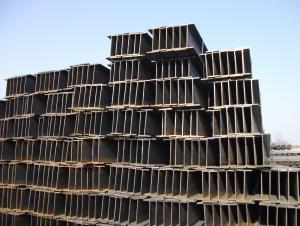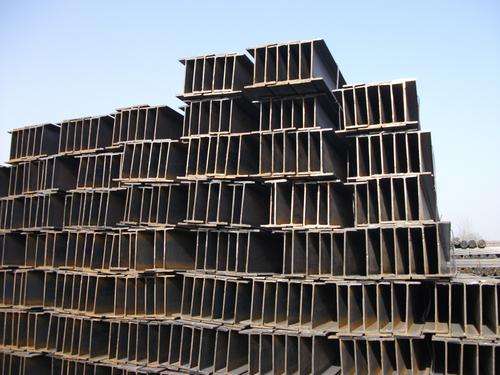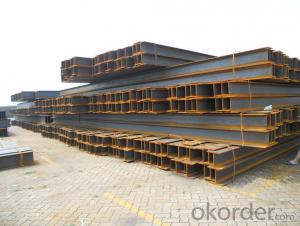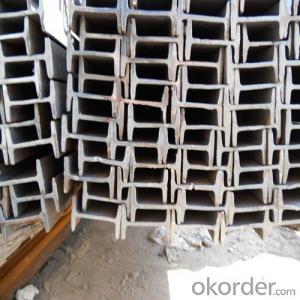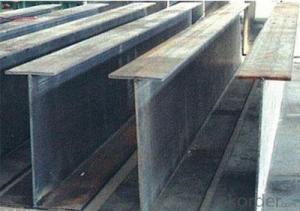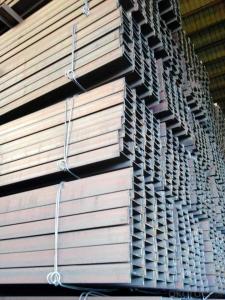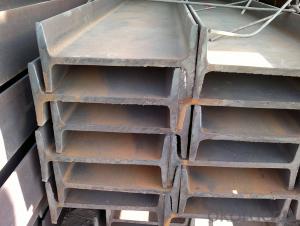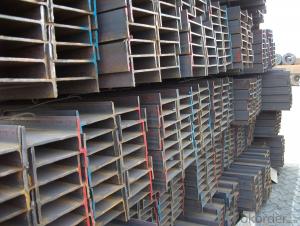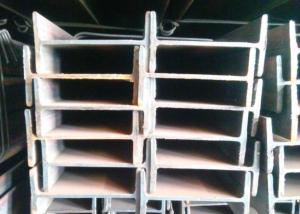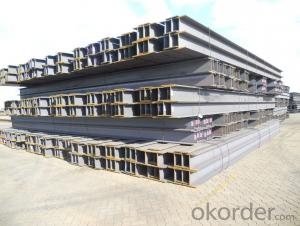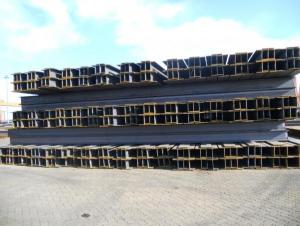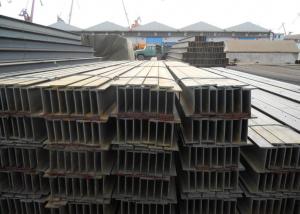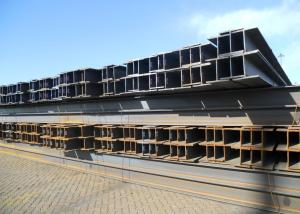I beam
- Loading Port:
- China Main Port
- Payment Terms:
- TT OR LC
- Min Order Qty:
- -
- Supply Capability:
- -
OKorder Service Pledge
OKorder Financial Service
You Might Also Like
Usage & Applications of Hot Rolled Steel H-beam For Sale
Commercial building structure ;Pre-engineered buildings; Machinery support structure; Prefabricated structure; Medium scale bridges; Ship-building structure.etc.
Packaging & Delivery of Hot Rolled Steel H-beam For Sale
1. Packing: it is nude packed in bundles by steel wire rod
2. Bundle weight: not more than 3.5MT for bulk vessel; less than 3 MT for container load
3. Marks:
Color marking: There will be color marking on both end of the bundle for the cargo delivered by bulk vessel. That makes it easily to distinguish at the destination port.
Tag mark: there will be tag mark tied up on the bundles. The information usually including supplier logo and name, product name, made in China, shipping marks and other information request by the customer.
If loading by container the marking is not needed, but we will prepare it as customer request.
4. Transportation: the goods are delivered by truck from mill to loading port, the maximum quantity can be loaded is around 40MTs by each truck. If the order quantity cannot reach the full truck loaded, the transportation cost per ton will be little higher than full load.
5. Delivered by container or bulk vessel
- Q: What are the considerations when designing connections for Steel H-Beams?
- When designing connections for Steel H-Beams, there are several important considerations to keep in mind. Firstly, it is crucial to understand the load and forces that will be acting on the connection. This includes considering the magnitude, direction, and type of loads, such as vertical loads from the weight of the structure or horizontal loads from wind or earthquakes. This information is essential for determining the appropriate size and type of connection that can safely transfer these forces. Secondly, the material properties of the steel beams must be taken into account. This includes factors such as the yield strength, tensile strength, and stiffness of the steel. These properties determine the overall structural capacity and behavior of the connection, helping ensure it can adequately support the loads. Another consideration is the type of connection to be used. There are various options available, each with its own advantages and limitations. Common types include bolted connections, welded connections, and moment connections. The choice depends on factors such as the structural requirements, ease of installation, and the expected behavior under load. Furthermore, the design must consider the potential for fatigue or corrosion. Fatigue can occur due to repeated loading, while corrosion can weaken the connection over time. Adequate protection measures, such as coatings or detailing, should be incorporated to mitigate these risks and ensure the long-term durability of the connection. Lastly, it is important to comply with relevant design codes and standards. These provide guidelines and requirements for designing connections, ensuring they meet safety and performance criteria. Following these codes helps ensure that the connection is designed to withstand the expected loads and provides a reliable and safe structural solution.
- Q: How do steel H-beams perform in terms of fire resistance?
- Steel H-beams perform well in terms of fire resistance. Due to their composition and structural design, steel H-beams have a high melting point and are less prone to deformation or collapse under high temperatures. This makes them highly resistant to fire and allows them to maintain their structural integrity for longer durations during a fire incident. The fire resistance of steel H-beams is further enhanced by the application of fireproofing materials, such as intumescent coatings or fire-resistant insulation. These materials create a protective layer on the surface of the beams, which expands when exposed to heat and forms an insulating barrier. This barrier slows down the transfer of heat to the steel, thereby increasing its fire resistance and preventing premature failure. Additionally, steel H-beams have excellent load-bearing capabilities, even at elevated temperatures. This means that in the event of a fire, they can continue to support the weight of the structure and prevent catastrophic collapses. This is particularly important in buildings and structures where fire safety is a critical concern, such as high-rise buildings, industrial facilities, or infrastructure projects. It is worth noting that while steel H-beams have good fire resistance, they are not entirely fireproof. In extremely high-temperature conditions, such as those found in intense fires, the steel may eventually weaken and lose its load-bearing capacity. However, compared to other building materials, steel H-beams offer superior fire resistance, making them a popular choice in construction projects where fire safety is a priority.
- Q: What are the common applications of steel H-beams?
- Steel H-beams have numerous common applications in the construction and engineering industries. They are widely used as structural supports in buildings, bridges, and infrastructure projects due to their high strength and load-bearing capacity. H-beams are also commonly utilized in the fabrication of heavy machinery, such as cranes and equipment frames, as well as in the construction of mezzanines, platforms, and industrial structures. Their versatility, durability, and ability to withstand heavy loads make steel H-beams a popular choice in various construction applications.
- Q: Can steel H-beams be used for stadium construction?
- Yes, steel H-beams can be used for stadium construction. H-beams are a common structural element used in construction due to their high strength and versatility. They are capable of supporting heavy loads and providing stability to large structures like stadiums. Additionally, steel H-beams offer several advantages such as durability, fire resistance, and the ability to withstand extreme weather conditions. Their use in stadium construction allows for the creation of large open spaces without the need for intermediate columns, providing unobstructed views for spectators. Overall, steel H-beams are an excellent choice for stadium construction due to their structural integrity and suitability for supporting the unique requirements of such large-scale projects.
- Q: How do steel H-beams perform in high-traffic areas?
- Steel H-beams perform exceptionally well in high-traffic areas due to their strong load-bearing capacity and durability. They are designed to withstand heavy loads and provide excellent structural support, making them ideal for use in bridges, highways, and other high-traffic infrastructure projects.
- Q: Are steel H-beams susceptible to fatigue?
- Indeed, steel H-beams are prone to fatigue. Fatigue occurs when a material weakens and breaks due to repeated cycles of stress. Just like any other structural components, steel H-beams can undergo fatigue if they are exposed to loads that repeat or fluctuate over time. These repeated stress cycles have the potential to create cracks in the material, which can eventually lead to failure. Factors such as the size, frequency, and duration of the applied loads, as well as the quality and condition of the steel, can influence how susceptible the beams are to fatigue. In order to prevent fatigue failure, engineers and designers must carefully analyze the anticipated loads and apply appropriate design standards. This may include incorporating safety margins, conducting fatigue analysis, and implementing thorough maintenance and inspection protocols.
- Q: How do steel H-beams contribute to the stability of tall buildings?
- Steel H-beams contribute to the stability of tall buildings in several ways. Firstly, these beams are designed to provide structural support and distribute the weight of the building evenly. The H-shape of the beam allows for a larger surface area to bear the load, making it more efficient in handling vertical and horizontal forces. Secondly, steel H-beams have high strength and stiffness properties, making them capable of withstanding tremendous amounts of pressure and bending moments. This characteristic ensures that the beams remain rigid and stable, even in the face of external forces such as wind, earthquakes, or heavy loads. Additionally, steel H-beams can be bolted or welded together to form a rigid framework, creating a strong and durable structural system for tall buildings. This framework acts as a skeleton, providing stability and preventing the building from sagging or collapsing under its own weight. Furthermore, steel H-beams are versatile and can be fabricated to meet specific architectural and engineering requirements. These beams can be customized in terms of size, length, and strength, allowing for precise design and construction of tall buildings. This versatility ensures that the beams can effectively support the unique loads and forces experienced by each individual structure. In summary, steel H-beams contribute to the stability of tall buildings by providing structural support, distributing the weight evenly, withstanding external forces, forming a rigid framework, and offering versatility in design and construction. These beams play a crucial role in ensuring the safety and integrity of tall buildings, making them an essential component of modern construction.
- Q: Can steel H-beams be used in industrial buildings?
- Yes, steel H-beams are commonly used in industrial buildings due to their strength, durability, and versatility. They provide excellent structural support and can withstand heavy loads, making them ideal for large-scale industrial construction projects.
- Q: Are steel H-beams suitable for use in the construction of water treatment plants or facilities?
- Yes, steel H-beams are suitable for use in the construction of water treatment plants or facilities. Steel H-beams are known for their strength, durability, and load-bearing capacity, making them ideal for supporting heavy structures in water treatment plants. Additionally, steel is resistant to corrosion, which is crucial in a water treatment environment where exposure to moisture and chemicals is common. Overall, steel H-beams provide a reliable and long-lasting structural solution for water treatment facilities.
- Q: Can steel H-beams be used for sports arenas or stadiums?
- Indeed, sports arenas or stadiums can utilize steel H-beams. These beams are frequently employed in the construction sector owing to their robustness and adaptability. They furnish exceptional structural support, rendering them appropriate for extensive undertakings such as sports arenas or stadiums. The beam's H shape permits an augmented load-bearing capacity, making it an optimal choice for enduring the weight of a stadium's roof, seating sections, and other infrastructure. Moreover, steel H-beams are renowned for their endurance and resilience against environmental elements like weather and seismic activity, which establishes them as a dependable selection for enduring sports facilities.
Send your message to us
I beam
- Loading Port:
- China Main Port
- Payment Terms:
- TT OR LC
- Min Order Qty:
- -
- Supply Capability:
- -
OKorder Service Pledge
OKorder Financial Service
Similar products
Hot products
Hot Searches
Related keywords
